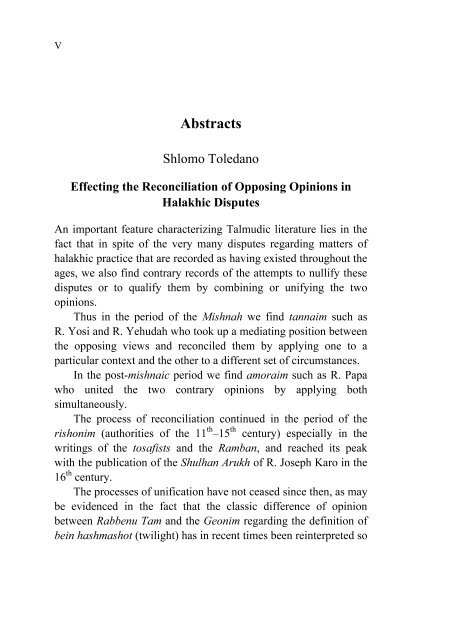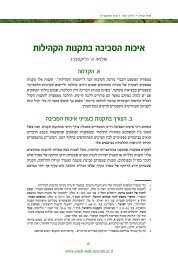ע - מכללת ליפשיץ - Macam
ע - מכללת ליפשיץ - Macam
ע - מכללת ליפשיץ - Macam
You also want an ePaper? Increase the reach of your titles
YUMPU automatically turns print PDFs into web optimized ePapers that Google loves.
V<br />
Abstracts<br />
Shlomo Toledano<br />
Effecting the Reconciliation of Opposing Opinions in<br />
Halakhic Disputes<br />
An important feature characterizing Talmudic literature lies in the<br />
fact that in spite of the very many disputes regarding matters of<br />
halakhic practice that are recorded as having existed throughout the<br />
ages, we also find contrary records of the attempts to nullify these<br />
disputes or to qualify them by combining or unifying the two<br />
opinions.<br />
Thus in the period of the Mishnah we find tannaim such as<br />
R. Yosi and R. Yehudah who took up a mediating position between<br />
the opposing views and reconciled them by applying one to a<br />
particular context and the other to a different set of circumstances.<br />
In the post-mishnaic period we find amoraim such as R. Papa<br />
who united the two contrary opinions by applying both<br />
simultaneously.<br />
The process of reconciliation continued in the period of the<br />
rishonim (authorities of the 11 th –15 th century) especially in the<br />
writings of the tosafists and the Ramban, and reached its peak<br />
with the publication of the Shulhan Arukh of R. Joseph Karo in the<br />
16 th century.<br />
The processes of unification have not ceased since then, as may<br />
be evidenced in the fact that the classic difference of opinion<br />
between Rabbenu Tam and the Geonim regarding the definition of<br />
bein hashmashot (twilight) has in recent times been reinterpreted so
















